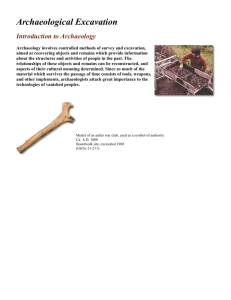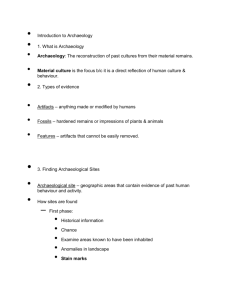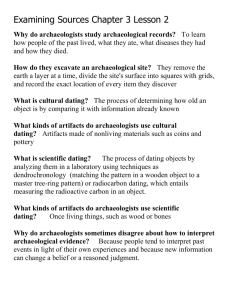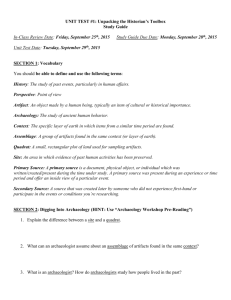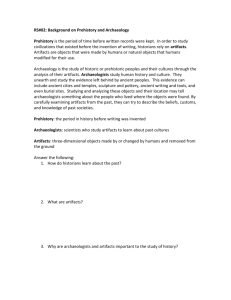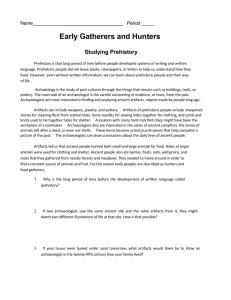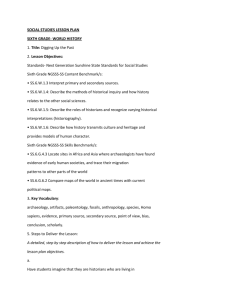The Job of historian and archaeologist
advertisement
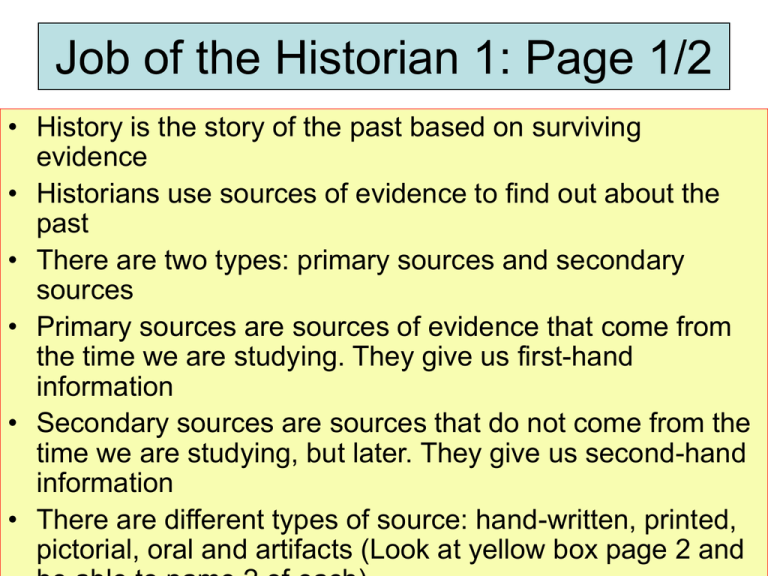
Job of the Historian 1: Page 1/2 • History is the story of the past based on surviving evidence • Historians use sources of evidence to find out about the past • There are two types: primary sources and secondary sources • Primary sources are sources of evidence that come from the time we are studying. They give us first-hand information • Secondary sources are sources that do not come from the time we are studying, but later. They give us second-hand information • There are different types of source: hand-written, printed, pictorial, oral and artifacts (Look at yellow box page 2 and Job of the Historian 2: Page 2 / 3 • An artifact is something made and used by people in the past • A museum is a place where artifacts are stored and displayed • An archive is a place where documents like manuscripts and photographs are stored • An art gallery is a place which contains paintings, sculptures and drawings • Sources can be unreliable as evidence: they lie; they are mistaken; be biased (one-sided) or prejudiced (they make up their mind because they like or dislike the thing, not because of the facts) • Propaganda means spreading lies and half lies to persuade a lot of people to act a certain way. Archaeologist 1 • • An archaeologist studies prehistory (the time before writing) The difference between history and archaeology is history is the study of the past based mainly on written sources; archaeology is the study of the past based on artifacts • Archaeologists must find sites: they use aerial photographs, old maps and legends to find them. • Sometimes they are found by accident when building is going on • Famous archaeology sites in Ireland are a) Mount Sandel b) The Ceide Fields c) Lough Gur • Old buildings, burial sites and middens (ancient rubbish heaps) are the best sites Archaeologist 2: People in history 1. 2. Archaeologists study prehistory by finding and studying artifacts They find sites using aerial photographs, maps, legends and sometimes by accident 3. They must protect the site from frost and rain with plastic. They must protect the site from people with fences 4. An archaeological dig (excavation) must be carried out properly 5. First, they use a digger to remove the topsoil. 6. They then make a map of the site 7. They divide the site into a grid using rope, and mark each square with a number and letter 8. Each grid is dug out (excavated) very carefully using small tools, so that no artifact is broken or overlooked. They use trowels, small brushes, buckets, pickaxes and sieves. 9. The location of the find is recorded on the plan and in the notebook. The artifact is photographed, labelled and put in a plastic bag 10. It is sent to the laboratory to be dated and then to a museum. Dating Artifacts • Straitography is a method of dating artifacts because artifacts found deeper in the ground are older • Dendro-chronology is a method of dating wooden artefacts using the pattern of rings in the wood • Carbon dating is a method of dating organic artifacts because all living things contain carbon. They lose the carbon slowly and steadily. Archaeologists can tell how old it is by how much carbon is left • Pollen analysis tells us what plants grew in the past. Pollen last thousands of years and this can help us to date sites. Chronology • • • • • A decade is 10 years A century is 100 years A millenium is 1000 years BC means before the birth of Christ AD means after the birth of Christ Ist century BC 2nd century AD

